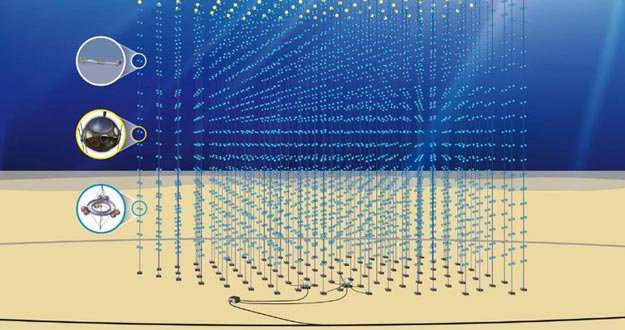Today, I should like to bring you a news that, exactly, said the following: “The largest neutrino telescope in the world is prepared in Valencia”.
KM3NeT will be the first experiment, to detect cosmic neutrinos, with very high energy, in the northern hemisphere, from the sea. This week, Valencia (eastern Spain) hosts a meeting of a hundred researchers, to discuss about this experiment and another known as ANTARES.
These two experiments consist of a series of detectors, arranged in line and submerged more than 2,000 meters deep, in the Mediterranean. Their spheres, with ultrafast sensors, capture the light signal, that emit particles, created by neutrinos, with very high energy, to interact with matter.

Design of the arrangement of the sensors of the KM3NeT telescope
This bluish light, called Cherenkov light, is a type of electromagnetic radiation, produced by the particles, charged in water, when traveling in it faster than light.
These neutrinos have energies, much higher than the particles, produced by the Large Hadron Collider (LHC). Experts are still debating their origin, although supernova explosions, the active centers of galaxies, where there are huge black holes, or gamma ray bursts, would be some of their sources.
As they have no electric charge and barely mass, "neutrinos are very interesting, to study the cosmos, as they travel intergalactic distances, without being absorbed or deflected, something not possible, with photons or cosmic rays", explains Juan José Hernández Rey , CSIC research professor, at IFIC, participant in KM3NeT and one of the organizers of the meeting.
This new way of studying the universe, through neutrinos, was proved, in late 2013, when a similar experiment, at the South Pole, called “IceCube”, reported in Science, the detection of the first cosmic neutrinos, of very high energy, whose origin is outside our system Solar.
"This has advantages", Juan de Dios Zornoza Gomez explains, hired Ramon y Cajal of the University of Valencia, in the IFIC, and participant in KM3NeT. "From the northern hemisphere, we have better visibility of the center of our galaxy, and, in the water, can be better reconstructed the direction of arrival of these neutrinos, which is essential for a telescope".
In the Valencia meeting, the progress made with ANTARES, which takes data from 2008, in front of the coast of Toulon (France) and that, although it has not seen signs of neutrinos of astrophysical origin "because of their modest size" are presented, has shown the viability of the technology.
The researchers also discuss about plans, for the construction of KM3NeT (acronym for neutrino telescope cubic kilometer), which plans to install 12,000 sensors, distributed in several cubic kilometers in front of the coast of Marseille (France), Sicily (Italy) and Pylos (Greece).
The first phase of the installation comprises 558 modules, in French and Italian sites, during 2015 and 2016. The next phase will be extended until 2020; but, there is still no date, for completion of the original design. However, researchers can take data, since the first line of sensors are installed.
In Valencia, the results of the latest tests for Sensor lines, that will be installed, this year, as well as the system design calibration of the detector is exposed. KM3NeT is an international collaboration, consisting of more than 200 scientists and technicians, from 40 institutions and 10 countries.
The Spanish scientific participation is led by the Institute of Physics Corpuscular (IFIC, CSIC-University of Valencia), with support from the National Center for Particle Physics, Astroparticle and Nuclear (CPAN).
From the IFIC, are designed crucial elements, in the electronics modules, with sensors and temporal calibration system.
Physicists of this center also work, in identifying sources of neutrinos and their use, as indirect search for dark matter, which is a quarter of the universe; but it has not yet been detected.
In addition to the physic goals, that they hope to achieve, KM3NeT provides an ideal platform, for studying marine biology and geology.
Other Spanish groups, participating, are the Institute for Integrated Management of Coastal Zone (IGIC) of the Polytechnic University of Valencia, in Gandia, and the Laboratory of Applied Bio-Acoustics (LAB) of the Autonomous University of Barcelona.
KM3NeT has received European funding, for its preparation and design, while the participating countries finance the construction, mainly France, Italy and the Netherlands.
Well, although I have studied Letters, I understand that Science is very important, for the development of Society: Improvement in Health, Communications, etc.
Also, I hope that you consider important this news.
Until my next post, kind regards,
Luis.
Sponsored by Costaluz Lawyers.
Please click below:
